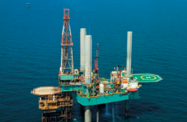Renewable energy projects both at home and abroad continue to constitute a growing part of Abu Dhabi’s investment portfolio, as the emirate pursues what has long been a central part of its diversification strategy.

In May Abu Dhabi Water and Electricity Authority (ADWEA) closed a project finance agreement for the 1.17-GW Noor Abu Dhabi, a project set to be the largest independent solar plant in the world. The photovoltaic (PV) facility will cost $872m – of which $650m will be debt and $222m equity – and is slated to be operational by the second quarter of 2019.
Located in Sweihan, 120 km south-east of the capital, the project is being implemented by the Sweihan PV Power Company, a consortium led by ADWEA (60%) alongside Japan’s Marubeni Corporation (20%) and China’s JinkoSolar Holding (20%).
The May announcement comes on the heels of a power purchase agreement in March stipulating that Marubeni and JinkoSolar would construct, own, operate and maintain the PV plant under a 25-year deal.
In terms of capacity, Noor will be larger than India’s 648-MW Kamuthi Solar Power Project located in the state of Tamil Nadu, as well as California’s 550-MW Desert Sunlight Solar Farm.
Abu Dhabi’s investment in solar off to a strong start
The Noor project builds on the solid foundation Abu Dhabi has developed in renewable energy, a sector with a central role in targets set out at a federal level. The UAE’s Energy Plan 2050 aims to shift the energy mix in the UAE to 44% renewables by that year, whereas fossil fuels currently make up around 90% of energy needs.
Abu Dhabi’s investments both within the UAE and abroad have been spearheaded by local renewable energy and clean technology firm Masdar, launched in 2006 and owned by Mubadala Investment Company. Research around renewables was carried out largely by the associated Masdar Institute of Science and Technology until early 2017, when the institution was consolidated under the umbrella of the government-owned Khalifa University of Science and Technology.
The emirate’s credentials in renewable energy development were underscored in 2011 when the International Renewable Energy Agency (IRENA) moved its head office to Masdar City, the region’s first sustainable urban development.
In 2013 Masdar launched its first utility scale project, the 100-MW Shams 1 by Shams Power Company, a joint venture between Masdar (60%), Total (20%) and Abengoa Solar (20%). This was the first solar project in Abu Dhabi and, at the time, the largest concentrated solar power plant in the Middle East, according to the company.
More recently, in November 2016, Masdar closed a power purchase agreement with Dubai Water and Electricity Authority to build the third phase of the Mohammed bin Rashid Al Maktoum Solar Park in Dubai, a phase expected to add 800 MW to the PV park’s capacity and be operational in 2020.
The deal’s low price factor, whereby ADWEA will purchase output at $2.99 per KWh, is part of a broader trend in declining costs around renewable energy – in September 2016, Sweihan PV Power Company had submitted a bid at $2.41 per KWh, a record low for a project of this size.
“The cost of electricity generation of both solar and wind technologies has declined dramatically in the past decade and continues to do so,” Mohamed Jameel Al Ramahi, CEO of Masdar, told OBG. “Depending on geography and specific project, these technologies are now very competitive with conventional electricity generation. As a result, the solar and wind installed base has been growing at over 15% annually in the past 5 years, a growth expected to continue into the next decade. This has led to changes in the market, including significant reduction in government support schemes and a more competitive environment, with different types of market participants entering the market. For renewables, there is an exciting future ahead.”
Long-term trends in solar investment gives Abu Dhabi upper hand
Abu Dhabi’s early investments in renewables are likely to serve it well in the long term, as solar becomes ever more cost-effective and sustainable when compared to traditional forms of energy.
In many countries the cost of deployment for unsubsidised solar energy has already surpassed coal and natural gas. The Middle East, benefitting from weather conditions favourable to solar power generation, is likely to remain a major investor in this field, alongside its vast hydrocarbons wealth.
As a group, emerging markets have already surpassed the OECD in renewable energy investments, spending a total of $154.1bn in 2015 against the latter’s $153.7bn.
Some 72% of the $10.2trn projected spend worldwide on power generation in the years to 2040 will be on wind and solar PV plants, according to Bloomberg. For solar electricity, the levelised energy cost is expected to drop another 66% by the same year.


